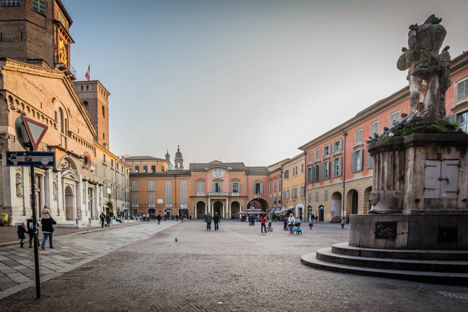
A closer look at Reggio Emilia: one of the regions famous for producing Parmigiano Reggiano
Italy’s Emilia-Romagna is famed for including the provinces where Parmigiano Reggiano can be produced. Between the more well-known cities of Parma and Modena lies Reggio Emilia, a city forever linked to this king amongst cheeses. Learn more about the dishes and ingredients found there and discover how Parmesan is intertwined into many of the local specialities.
A closer look at Reggio Emilia: one of the regions famous for producing Parmigiano Reggiano
Italy’s Emilia-Romagna is famed for including the provinces where Parmigiano Reggiano can be produced. Between the more well-known cities of Parma and Modena lies Reggio Emilia, a city forever linked to this king amongst cheeses. Learn more about the dishes and ingredients found there and discover how Parmesan is intertwined into many of the local specialities.
Stretching from the banks of the Po River all the way down to the Apennine mountains and covering most of the width of Italy, Emilia-Romagna is one of the country’s biggest regions. But it’s not size that makes Emilia-Romagna famous; it’s the area’s gastronomic history and traditions. Within this rich history is the production of Parmigiano Reggiano, which can only be produced in a specific part of Emilia Romagna (including the provinces of Parma, Reggio Emilia, Modena, parts of Bologna), and parts of Mantua in neighbouring Lombardy.
When Parmigiano Reggiano was first produced by Benedictine monks nearly 1,000 years ago, it was made from the milk of cows raised on the plains between Reggio Emilia and Parma, which is where the name of the cheese originates from. Nowadays, Parmigiano Reggiano can be made in a specific surface area of approximately 10,000 square kilometres across five provinces in northern Italy, and one of those is Reggio Emilia. However, while Parmigiano Reggiano is arguably the most well-known gastronomic delicacy to emerge from Reggio Emilia, it certainly isn’t the only one.
The area’s balsamic vinegar (Aceto Balsamico Tradizionale di Reggio Emilia DOP) is one of only three protected balsamic vinegars in the world, along with the more well-known variety from Modena. Made using the must of local grapes, the balsamic is aged in a series of progressively smaller wooden barrels for a minimum of twelve years and sometimes over twenty-five, giving it a complex flavour. Parmigiano Reggiano is traditionally paired with this vinegar for a perfect combination of saltiness and acidity, while Reggio Emilia’s local pan de re bread might make an appearance alongside. The Lambrusco grapes growing around Reggio Emilia aren’t only used for producing balsamic vinegar either; the area is also known to produce highly renowned wines from these vines, slightly sparkling reds being a particular speciality, which also pair deliciously with Parmigiano Reggiano.
As you might expect for a region with such a rich collection of artisan produce, Reggio Emilia also has a number of its own traditional local dishes. Unsurprisingly, most of these speciality dishes are made from or tend to come accompanied by the province’s proudest export – Parmigiano Reggiano. Erbazzone is a savoury pie which originates from the city and comes stuffed with a filling made from vegetables, bacon, and Parmigiano Reggiano. A dish originally designed to be made quickly with a handful of ingredients, erbazzone has remained largely unchanged over the years, though the vegetables contained within it can vary. In the nearby town of Correggio, a very similar dish known as scarpasot is the speciality and only differs from erbazzone in the fact that it doesn’t feature any pastry. Both dishes, however, get their distinct, rich flavours from Parmigiano Reggiano.
A type of snack called chizze is another favourite amongst Reggio Emilia locals and originates from the city’s Jewish community in the early twentieth century. These bite-sized mouthfuls of fried dough are both stuffed and garnished with Parmigiano Reggiano and are readily available throughout Reggio Emilia from bakeries, cafés, and market stalls.
Of course, you can't forget the region’s speciality pasta dishes – most notably cappelletti, a variety of pasta which looks similar to tortellini but is closed by pressing rather than twisting – which without fail will be served with a generous flourish of the city’s famous cheese grated on top. Equally likely to be finished with plentiful amounts of Parmesan are pasta dishes from other Parmigiano Reggiano-producing regions such as Parma’s tortelli alle erbette or Bologna's world-famous tagliatelle al ragù alla Bolognese.
In a country with as rich a culinary heritage as Italy, it’s unsurprising that its different regions have such distinct culinary identities. But what ties Reggio Emilia together with Parma, Modena, Bologna, and Mantua is the importance it places on Parmigiano Reggiano. Not only do many of these regions' most classic dishes feature the cheese but it’s also part of their broader culture and identity.

